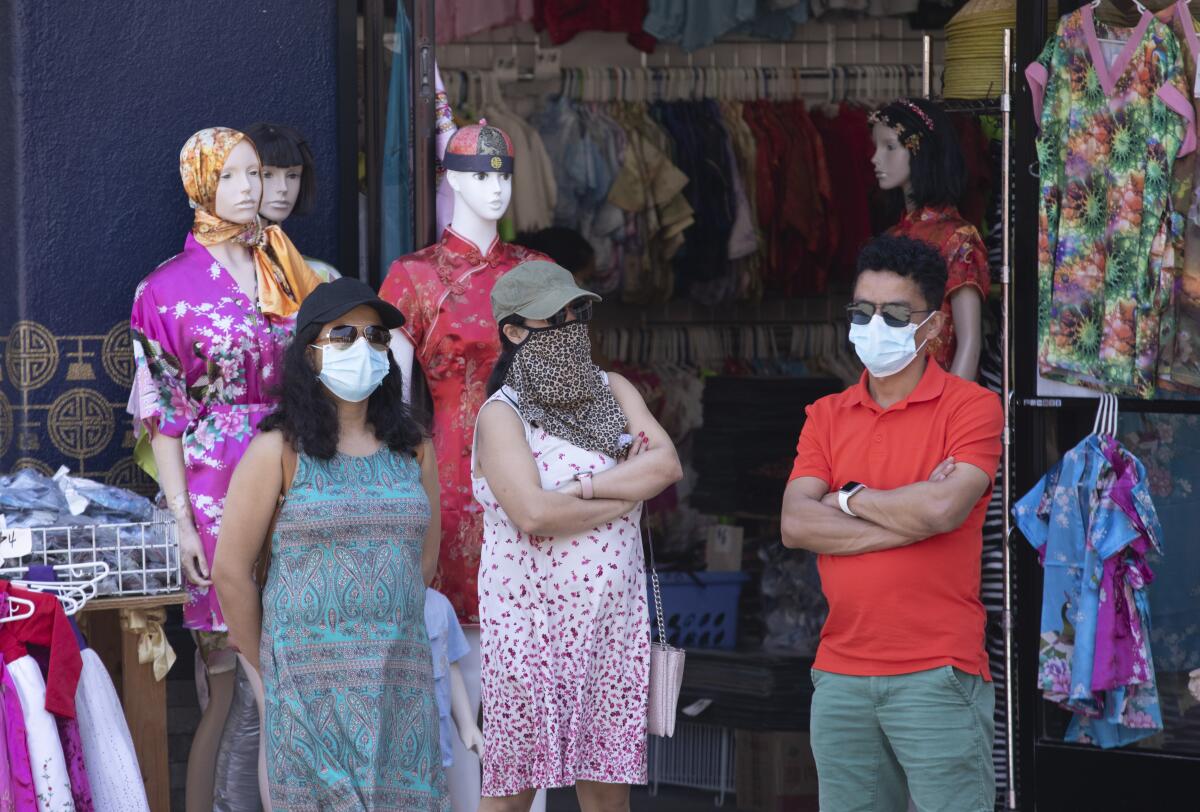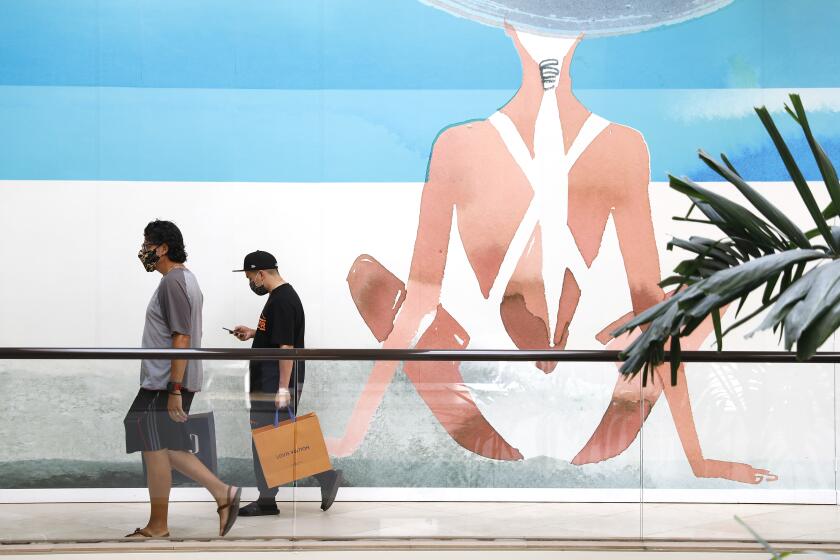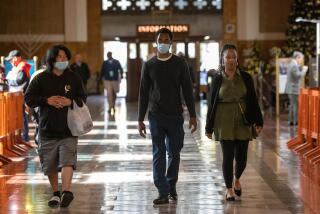Column: Masks or no masks? Shaming or no shame? New phase of COVID-19 upends all we’ve learned

So here we go, California, jumping from pandemic to endemicity — dragging with us a new word and the heavy psychological baggage that the COVID emergency is over, but COVID-19 isn’t.
What am I supposed to do with that?
Do I wear a mask to the grocery store? Do I prep my kids to take them off at school? What happens if, God forbid, I ditch the mask only to commit a bare-faced sneeze in public (although a masked one was no joy)?
On Thursday, Dr. Mark Ghaly, head of California’s Health and Human Services Agency, announced the state is moving to a “SMARTER” approach to COVID-19 (that’s the painfully clever acronym for shots, masks, awareness, readiness, testing, education in the form of open schools, and treatments — Rx — to make it work). Ghaly’s comments came one day after the state lifted its indoor mask mandate.
Translation? To steal from Tom Petty (who knew waiting is the hardest part) it’s time to move on, it’s time to get going.
The news didn’t feel like a relief. It felt like the floating anxiety of the last two years swelled into another wave of ambiguity. While local rules may stay in place, the announcement is a strong indication that spring and summer will demand more personal choice with fewer guidelines to rely on — what Ghaly described as “gliding into normal.”
Or, as Vaile Wright, spokeswoman and innovation director for the American Psychological Assn., explained it to me, things just got “more complicated.”
I want the pandemic to be over. I want all of us to move forward to a future where we are telling our clueless grandkids about the great upheaval of 2020. But the truth is there is no scientific consensus on whether we are ready to declare endemicity or not. Gov. Gavin Newsom avoided using the term “endemic” in his comments Thursday — though that’s clearly what his plan is about. An even harder truth is that there is no right answer for California or for the country. This is just one more instance of COVID casuistry when we all have to decide for ourselves how we will behave.
California officials outline a plan that assumes the coronavirus and its variants will ebb and flow, requiring flexibility in such activities as mask wearing.
Critics have berated Newsom for poor communication since the virus first hit Bay Area-bound cruise ships (I’ve lobbed that rebuke myself). He’s argued in favor of local control, frustrating many for what seemed like a wishy-washy position meant to dodge tough decisions when all of us desperately wanted clarity. Although, granted, he took the bold move of issuing stay-at-home orders in March 2020, the first governor in the nation to do so.
But COVID-19 has proven itself both regional and political, as much as viral, and it’s increasingly clear there will never be blanket solutions.
There are parts of California that are still deeply in a pandemic — 83,000 Californians have died from the virus, and more than 200 continue to die every day, according to my colleagues Luke Money and Rong-Gong Lin II. There are other areas that have, through local restrictions, hard equity work and personal responsibility, made it to a point in which it can be fairly argued that the risk of dying from the virus or overloading hospitals is down far enough to justify the endemic approach.
The state isn’t washing its hands of COVID-19, to be clear (but it would appreciate you continuing to wash yours). The SMARTER plan is about being ready for the next variant, and trying to isolate it. It includes surveillance such as increased use of poop police who will monitor and genetically sequence strains in wastewater; stockpiles of supplies including masks, tests and ventilators; investments for developing new technologies; and a plan for 3,000 emergency medical staff if the worst happens. It may also include going back to strongly recommended masking, at least in certain places, if there is an outbreak.
Many health experts are strongly recommending the public still wear masks even as the state lifted its order requiring them to be worn in indoor public spaces for vaccinated people.
What living SMARTER might also mean is a period of uncomfortable and deeper divisions as we figure out how to take the masks off. Despite the ugliness of the political fights around COVID-19, the resulting tribalism has provided many with some comfort and direction. If you believe in the science and in being a responsible citizen, there was a satisfaction and unity in joining with others who were adhering to the same rules and values.
For many of us, the anti-maskers and anti-vaxxers have been the troublesome tribe — the one we wanted to avoid. We’ve been fine dishing out group shaming of those who defied the greater good, satisfied by our virtuosity.
The endemic approach does away with those tribes. Suddenly, we each have to decide when we will wear a mask and when we won’t, for our own health and for others.
None of the need to weigh our freedoms against our values is diminished, though. The choices are just more lonely. The vulnerable still remain vulnerable. Racial disparities still exist — Black and Latino communities have weathered an unfair share of risk and death and that will not change. The immunocompromised, kids too young to be vaccinated, those with underlying conditions as common as obesity — our obligations to them remain.
Dr. Sergio Aguilar-Gaxiola, director of the Center for Reducing Health Disparities at UC Davis, said that though he supports the governor’s plan, he’s worried for communities such as farmworkers, where the coronavirus positivity rate has bounced as high as 40% in recent weeks, even as state statistics fall. He points out that when it comes to deaths in younger people from COVID-19, they are overwhelmingly people of color, especially Latinos.
Grappling with how to responsibly navigate such realities is what the next wave looks like, warns Ben Rosenberg, a professor of psychology at Dominican University of California in Marin. We will confront the anxiety of pursuing our personal comfort and long-sacrificed pleasures with the social and health ramifications of de-masking.
Rosenberg has been studying reactions to pandemic messaging and presented his research at a conference in San Francisco this week, one where attendees had to prove they were tripled vaxxed. But speakers were taking off their masks when they were onstage, and he did the same.
It felt “kind of liberating, I guess?” he said with little certainty. He just got back from a road trip with his wife and 3-year-old that wound through Colorado and Utah, where masks were far less common. He felt a sense of jealousy, he said, “of the people who are just like of the F-it mindset.” But like most of us, that’s not who he is. So he’s conflicted. He’ll probably keep wearing his mask to the grocery store, for now.
Outdoor music festivals are considered safe, but some ticketholders are rethinking their Coachella attendance in wake of safety protocols being eliminated.
Steven Taylor, a professor of clinical psychology at the University of British Columbia, literally wrote the book on pandemic psychology before the coronavirus hit. He warns we also need to be ready for the gloaters, those who see moving to endemic plans as an admission that everything prior was unnecessary.
“Anti-maskers will declare victory,” he predicted. They’ll say, “Yes, we won, see, I told you these masks were worthless.”
Oh, good, we have that to look forward to.
The path through endemicity isn’t all negative. That research just presented by Rosenberg was focused on what happens when you hit anti-maskers with “soft” messaging instead of mandates. Turns out that feels a bit like freedom to them, Rosenberg said, cutting down on the “super-duper resistance.”
He’s hopeful that moving away from mandates might actually lead to more voluntary masking from its staunchest opponents.
And for the rest of us, Wright, the psychologist, offers this advice: “Leave some of that judgment at the door,” even for ourselves. What lies ahead, we have no way of knowing.
But it’s time to move on, time to get going.
More to Read
Sign up for Essential California
The most important California stories and recommendations in your inbox every morning.
You may occasionally receive promotional content from the Los Angeles Times.













